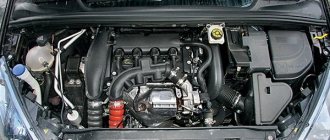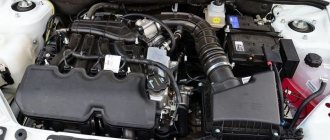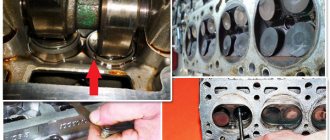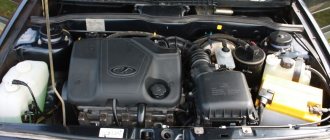3.9/5 — (117 votes)
Installation of HBO on 2106: multivalve
In the article you will learn about how to install gas equipment on a VAZ 2106, what are the requirements for this process. I also recommend reading about installing an LPG on a 4th generation car.
It should be noted that this guide is intended for informational purposes only; only the main points are described without a deep dive into the topic. If you are faced with the installation of gas equipment for the first time, then it is best to study in more detail the technical literature, as well as the recommendations of the gas equipment manufacturer.
What gas equipment is best to use for VAZ
For any car with a carburetor, the 1st or 2nd generation of LPG is better suited. Despite the fact that the 3rd and 4th generations are already being installed in full swing. But there is no point in installing a more modern HBO on a carburetor engine. The first generation differs from the second in little ways - only in the dispenser. The system itself is the same - the hose is connected to the carburetor through an insert into the carburetor. When a vacuum occurs in the intake manifold, it causes gas from the gearbox to flow through the dispenser into the carburetor.
In the 1st generation of gas equipment, a manual gas dispenser is used; it is enough to put it in the desired position once and there is no need to adjust it again. The 2nd generation has an electronic dispenser, which has a valve that changes its position depending on the readings of the oxygen sensor and the position of the carburetor throttle valve. Now there are many good companies that install 2nd generation gas equipment.
The second generation is not very well suited for classic carburetor VAZs, but this is not a problem; from the 2nd generation you can very easily make a 1st generation gas installation. To do this, you just need to install a mechanical dispenser instead of an electronic one.
In general, for a car with a carburetor engine, the 1st generation LPG is best suited.
How to adjust the gearbox yourself?
That's all, we figured out a little about how to install gas equipment on a car with a carburetor injection system with your own hands. Now let’s set it up correctly so that the consumption is lower and the throttle response remains the same as on gasoline. To do this, you need to use the following guide. First of all, you adjust the ignition; you need to set it a little earlier - turn the distributor body two notches (this corresponds to 10 degrees).
To make fine tuning, it is best to use electronic octane correctors. But for their normal functioning, a BSZ will be required. The reason for adjusting the ignition is that gas fuel has an octane rating of over 100. And if the adjustment is not made, the exhaust valves will burn out, and the cost of repairing them will be very significant.
You adjust the enrichment of the fuel mixture; the screw is located on the evaporator reducer. Make sure that the number of crankshaft revolutions is in the range of 800..900. Now it is necessary to adjust the gas fuel supply. To do this, you will need to screw the bolt on the valve until it stops. Then unscrew it two turns. This should be done with the engine turned off; after unscrewing the valve two turns, you can start it. Listen to how the engine works. If you sharply and briefly press the accelerator pedal, the revolutions should instantly reach 3000.
In this case, no delays should be observed. If the motor begins to “choke”, it is necessary to rotate the screw counterclockwise until this symptom disappears. You can do the entire setup yourself in just a few minutes, since only three screws can be adjusted. Screw in the second screw until it stops and turn it one turn counterclockwise. Start the engine and sharply depress the accelerator pedal.
Up to 6500 rpm, the crankshaft should spin up instantly. Please note that the second camera on a VAZ 2106 car should not open in the same way as the first. If it opens too much, the power will increase, but the consumption will increase significantly. And you won't feel any savings. Finally, the normal rotation speed is set by adjusting the XX screw.
Installation of the cylinder
To begin with, even before purchasing gas equipment, you need to decide what type of cylinder it will be: tablet-shaped or cylindrical. Usually, a cylindrical cylinder is most suitable for a classic VAZ; it has a large volume, and thanks to the large trunk, this cylinder will easily fit into it.
If the car is a hatchback, as in the 8 or 9, then it is better to install a tablet, and install it instead of a spare tire. This will save a lot of space, but you will have to drive more carefully and remember that there is no spare wheel in the car.
The cylinder must be securely fastened so that it does not dangle while driving. This is usually done using bolts and a metal stand.
After installing the cylinder, you need to decide which side the filling valve will be on. It is usually done at the bottom of the rear bumper; to do this, you need to drill a hole of the required diameter.
Installing LPG on a classic VAZ 2101-07
26 Sep 2014
While entering gas equipment into the registration certificate of his car, I met the owner of a Lada 2107, who installed the gas equipment himself, after which he entered it into the registration certificate at the MREO without any problems. Is this really possible? We decided to conduct an experiment.
To begin with, we studied a diagram of how you can install gas equipment yourself without going beyond the legal framework. Everything turned out to be simple. At the car market or from gas equipment installers, you buy a set of gas equipment with all the components, and then look for installation instructions on the Internet or from the gas specialists themselves. After installing the equipment, you go to the same gas equipment installers, and they pay a fee of 250–350 UAH. check the correctness of installation, if necessary, help set up and issue documents required for entering information about the presence of gas equipment into the vehicle registration certificate. Savings on re-equipment of a carburetor car is 500–800 UAH. For owners of old equipment, this is quite a large amount!
2200 per set
. The theory is good, but how, in practice, do you independently install the equipment on a carburetor car? Having two diplomas in automotive engineering specialties and experience in operating a car with LPG, I decided to check for myself how realistic it is and whether there are any difficulties. Friends suggested taking their VAZ-21011 with a 1.3-liter engine as a test subject. I have a car, now I need equipment. I found it at one of the capital's car markets. The set costs 2200 UAH. included a Lovato Aspirato vacuum reducer (according to experts, it lasts 150–180 thousand km, and the repair kit costs 120–200 UAH), a 50-liter cylindrical cylinder with a Tomasetto multivalve, cylinder fastening clamps, a mixer (popularly called a mixer), a filling station valve, gas supply tee to the carburetor, gas valve, gasoline valve, pipelines for liquefied gas, for gas in the vapor fraction (diameter 19 mm), for gasoline, for water-antifreeze (diameter 19 mm), two tees for connecting to the cooling system , clamps for clamping pipelines, a corrugated hose and plastic flanges for pipelines coming from the multi-valve under the bottom of the car, as well as an LPG control panel. Only special pipelines should be installed, otherwise gas and antifreeze may leak. Since there are no guarantees on the market, it is better to take Lovato or Tomasetto nodes - they are very reliable.
The gearbox (1) must be vertical and longitudinal in relation to the longitudinal axis of the vehicle. Otherwise, during braking, acceleration and on potholes, it will not work correctly due to flexion of the diaphragm. The gas valve (2) must be easily accessible to replace its filter.
The pipeline should not come into contact with moving parts and should not be on an open plane. Also, it should not be stretched - to compensate for temperature extensions and shortenings.
The gas supply dispenser to the two carburetor chambers has an adjusting screw that allows you to adjust the optimal gas flow.
The gasoline electric valve is installed in the circuit after the gasoline pump before the carburetor.
Installation subtleties
In order for gas equipment to work normally and not create problems when servicing the car, the installation process should be taken seriously. Thus, it is advisable to place the gearbox in the engine compartment as close as possible to the carburetor and engine cooling jacket. To eliminate the influence of acceleration and deceleration on the gearbox diaphragm, it must stand longitudinally (see photo). In the case of a VAZ classic, it is most convenient to connect it to the stove pipes. To do this, you will have to cut them and insert tees. It is also desirable that the reducer be positioned below the top pipe of the stove to ensure efficient circulation of fluid in the reducer.
The gasoline solenoid valve is conveniently located on the left side of the engine compartment near the brake master cylinder. It crashes into the hose from the fuel pump to the carburetor. The gas solenoid valve is located on the engine shield on the other side of the compartment. This placement of the valves is also optimal from a safety point of view, since in the event of a frontal collision there is a low probability of hitting the valve.
The mixer, i.e. the mixer, is installed under the carburetor. To ensure tightness during its installation, you need to use gaskets and preferably sealant, since in old cars the connecting planes of the manifold and carburetor may be deformed or have pockets of corrosion. It is also advisable to grind in the contact surfaces of the carburetor and mixer, otherwise the mixer gasket will burn out.
To install gas equipment on your own, it is most convenient to use not a copper pipeline, but a special plastic one, since it bends easily and does not require flaring of the ends. And for a sealed connection, special adapters with clamps are used, similar to those used in plumbing with metal-plastic pipes. A plastic pipeline is a little more expensive, but much more convenient to use and, in addition, it does not oxidize under the influence of acids contained in liquefied gas (propane-butane). By the way, oxidation products clog the gas filter faster.
To mount the cylinder in the trunk shelf above the rear axle, closer to the seats, two holes with a diameter of 10 mm are drilled. The other ends of the mounting clamp (it is better to take a rubberized one) can be attached without drilling the body. To do this, you need two pieces of steel strip 8–10 cm long. A hole is drilled in the center into which a fastening bolt is inserted. It is advisable to secure it with welding or glue. Next, this tee is inserted into the technological window from the side of the mentioned shelf (see photo), and the second ends of the clamp are screwed to it, clamping the cylinder. The cylinder fastener must prevent contact between the metal on the strip and the metal on the cylinder, which is why the tape is laminated. If the homemade product is made from a sheet of metal, you need to place cardboard or rubber.
When securing the cylinder, you should remember that it must be in a certain position. Thus, the axis of the landing window of the multivalve cylinder should be at an angle of 30° to the horizontal. In this case, the float will work correctly and the “sampling” of gas from the cylinder will be optimal. Holes for mounting the ventilation “corrugation” pipes should be made as close as possible to the luggage rack on which the cylinder stands, and under the multi-valve. This will reduce the useful volume of the trunk. The pipes in the lower part have oblique cuts. They need to be directed in different directions as the car moves. This ensures effective ventilation of the multivalve box.
The filling valve can be attached to any convenient location under the rear bumper. It is better to pull the pipeline to it along the spar on the other side of the muffler. It is better to lay the pipeline from the cylinder to the gas valve together with gasoline pipes (in parallel), and if this is not possible, away from the moving parts of the chassis (steering, suspension, transmission) and at the same time excluding its placement on the open plane of the bottom. Despite its high strength (it cannot be broken even with a hammer), if you get caught on a stump, the pipe can be torn out of the clamping pipe. The HBO control unit can be placed in the cabin in any convenient place. Next, find the “channel” for access to the engine compartment for connection to the valves - gasoline, gas and forced gas supply on the gearbox (starter wire). All wires are labeled, so there are no connection problems: the positive wires are connected to the marked terminals, and the negative wires are connected to the body.
The axis of the multivalve should be located at an angle of 30° to the horizontal. The places where holes were made in the body must be treated with anticorrosive.
The LPG control panel has two switches and a tank full indicator. One switch is “gas-neutral-gasoline”, the other is “gas leak”.
The ventilation pipes have cuts that need to be directed in different directions - for better ventilation of the multivalve box.
The filling valve can be located in any convenient location under the rear bumper.
It is better not to place it in the trunk, since if the seal is lost, gas will enter the cabin. Finish line
After assembling and checking the tightness of all pipelines, it is advisable to drive up to the gas workers to check the correct installation, and then you can go to the gas filling station. In this case, it is advisable to fill the cylinder with no more than 10 liters of gas - this will avoid large losses in the event of a leak in any connection. Before refueling, make sure that the gas supply valve to the reducer on the multivalve is closed and the gas supply valve to the cylinder is open. After refueling, you need to make a concentrated soap solution, which will allow you to check all gas hose connections for leaks. To do this, open the second valve of the multivalve and lubricate absolutely all connections from the filling valve to the carburetor with the solution. If a leak is detected in any connection, it should be tightened again. If this does not help, you need to re-disassemble the connection and “repack”.
“You can install LPG yourself, but this requires at least minimal knowledge of the design and operating principle of the vehicle’s power system. If this is not the case, it is better not to save.”
! To properly configure the LPG, you need a new air filter, working spark plugs and high-voltage wires. You also need to make sure that there is good compression in the cylinders and that there are no air leaks in the intake tract. Otherwise, you won’t be able to set up the HBO!
Finish
Once you are sure of the tightness, you can start the engine. In carburetor cars, it is advisable to start only on gasoline (gas causes overcooling of the gearbox diaphragm, which can shorten its life). After warming up the engine to a temperature of 50–60°C, switch to gas. Initially, the gearbox has average adjustments, so it is better to adjust it for a specific unit. To do this, there are two adjusting screws on the gearbox (idle speed and gas quantity) and another one or two (in our case, one) on the dispenser-splitter to the mixer under the carburetor.
We entrusted the adjustment to specialists, who then gave us documents for registering the gas equipment in the technical passport. It took a whole day to install the HBO. By the way, it is advisable to do this with an assistant. We spent another day making adjustments and obtaining a new registration certificate from the MREO.
Comment:
Installation of gas pipeline wiring
Next, you need to deal with the gas pipeline wiring. It is necessary to drill a hole from the cylinder valve to the engine compartment. Moreover, the gas pipeline is usually run along the bottom of the car.
To ventilate the multivalve, you need to drill a hole with a slightly larger diameter and insert a piece of plastic pipe into this hole.
These inserted tubes must be treated with mastic to prevent rust from appearing in the future. You need to run a gas line through these plastic tubes and secure it well so that it stays away from the moving parts in the car.
How to choose the type of gas
When choosing equipment, it is necessary to decide not only on the generation, but also on the type of fuel. Car cylinders can be refilled:
Let's briefly talk about the advantages and disadvantages. Propane does not require a thick-walled tank. Therefore, the container does not take up much space and has less weight, and this is important for VAZ passenger cars.
Propane gas stations are widely available throughout the country. The cost of a propane-butane installation is less, but the gas itself is more expensive than methane.
There are very few methane gas stations today. The cost of methane gas equipment is higher, and its dimensions and weight are greater.
Advantages of natural gas:
- saving money;
- safety;
- environmental friendliness.
For example, for the first version of the VAZ 2110 with 8 valves and Euro-2 standard, installing a methane-fueled gas system will make emissions cleaner and protect engine parts from carbon deposits. But methane cylinders are heavier, take up more space, and are more expensive to install, so such equipment is rarely installed on LADA.
Installation of a gasoline electric valve
The gasoline valve must be installed on the side of the pipeline supply to the gasoline pump. The valve is installed in the pipeline; to do this, you need to cut the pipeline, insert the valve there, and then use clamps to securely clamp the pipeline.
The main thing to understand is that the valve is located in the fuel line that runs from the fuel pump to the carburetor. The main thing is that the valve is not placed in front of the fuel pump, because while shutting off and supplying gasoline, the fuel pump will not be able to supply gasoline to the carburetor.
Engines and official fuel consumption rates of the VAZ-2106
Over the entire production period, the “six” was equipped with three variants of gasoline engines with a carburetor and a manual transmission with rear-wheel drive. Their advantages include:
- reliability;
- unpretentiousness;
- simplicity of design;
- low cost of repairs;
- economical fuel consumption of VAZ-2106.
The first version to appear was a 1.3 engine with 64 horsepower. With it, the “six” accelerated to the first hundred in 18 seconds, and the maximum speed reached 145 kilometers per hour. The car had the following fuel consumption figures per 100 kilometers:
- city mode 9.5 l;
- on the highway 7.6 l;
- mixed mode 8.3 l.
To meet the needs of potential buyers, they were offered a more powerful version with a 1.5 petrol unit and a power of 72 horses, a five-speed manual transmission. In this configuration, the VAZ-2106 accelerated to a maximum of 150 km/h, and reached the first hundred in 17 seconds. These figures were achieved with the following gasoline consumption per hundred kilometers:
- city 9.8 liters;
- track 8 liters;
- the average is 8.8 liters.
The most powerful and beloved by domestic car enthusiasts was the modification with a 1.6 engine with 75 horsepower - a reliable, dynamic unit. Paired with a balanced five-speed manual transmission, it accelerated the car to 155 kilometers per hour, and the dynamic acceleration to hundreds became 16 seconds. At the same time, fuel consumption per hundred increased slightly and amounted to:
- in city traffic 10.3 l;
- mixed mode 9.1 l;
- on a free road 7.4 liters.
All engines are designed for AI 92 gasoline, but can also run on other brands, both with lower and higher octane numbers.
How to install a gas valve
It is best to install the gas valve away from the gasoline valve; the further away, the safer. But the place must be accessible so that you can always reach the gas valve. A gas wire must be connected to the gas valve, which has already been laid from the gas cylinder to the engine. Next, we will discuss in more detail how to install the gearbox, control panel and dispenser.
About the Avtogaz-Moscow service
For 14 years, we have installed HBO on almost all popular models. It is convenient to combine the installation of HBO with routine vehicle maintenance. Within 5 hours we will install gas on your 2106 and, if desired, replace air filters, spark plugs, high-voltage wires, etc.
LPG suppliers in Russia
We are suppliers of gas equipment in the Russian Federation. We work only with proven European manufacturers. We are confident in the quality of the equipment we offer.
We provide a guarantee for up to 5 years!
cars equipped in our service
We install gas equipment
kilometers average payback of equipment
guarantee for all gas installation work
Gas reducer and its installation
It is best to install the gas reducer near the carburetor, and it should stand vertically to ensure a full gas supply; in addition, it is advisable to connect the reducer to the pipes going to the stove.
To do this, you need to use 2 tees and cut into the stove pipes. It is important that the inlet pipe of the gearbox cuts into the inlet pipe of the stove, and into the outlet pipe - the outlet pipe. And a gas pipeline must be connected to the reducer, which comes from the shut-off valve.
Setting up the vacuum reducer
There are two types of vacuum reducers:
- providing separate adjustment at idle speed, as well as sensitivity;
- having a combined regulator of these two settings.
In the first case, the adjustment is carried out similarly to the adjustment of the electronic gear described above. If the regulator is combined, as in the 2nd generation Lovato LPG for cars with a carburetor, the adjustment is as follows:
- the car starts using gas, the speed is adjusted by suction, up to two thousand per minute;
- the choke is gradually removed, the speed is set to maximum by tightening the screw that adjusts the idle speed;
- The same adjustment adjusts the number of revolutions, about a thousand per minute or a little more;
- With a similar setting, the speed is further reduced below the nominal value, and then again rises to a thousand per minute.
This is how the 2nd generation Lovato LPG is configured for the carburetor.
Installation of a gas mixture dispenser
Now it’s time to install the gas mixture dispenser; it is placed between the mixer and the gearbox, but it is also better to install it close to the carburetor. A gas pipeline must be installed to the dispenser, which comes from the reducer, and a gas pipeline must be led from it to the mixer.
The most important thing is that all the gas equipment parts are fixed in place, and the entire system is sealed.
Adjustment
After completing the checks, we begin adjusting the system.
- By switching the toggle switch on the button for selecting the type of fuel on which the car operates to the “Gasoline” position, we start the car engine in normal mode and warm it up with gasoline to operating temperature (80-90°C).
- While the engine warms up to operating temperature, unscrew the screw/screws on the dispenser to completely open the channel for the gas mixture to enter the mixer.
- We tighten the screw for supplying the mixture to chamber 2 until it stops.
- 1st – idle speed screw; it regulates the amount of propane-butane mixture that will be supplied to the engine when the gearbox diaphragm is closed.
- 2nd sensitivity screw, which regulates the opening moment of the membrane and the gas pressure when pressing the throttle.
- Before starting adjustments, turn screw 1 all the way, then unscrew it 1 turn, screw 2 turn it all the way and unscrew it 3 turns.
- When the engine reaches operating temperature (80-90°C), we move the fuel type switch to the neutral position (for engines equipped with a carburetor) to produce gasoline from the float chamber.
- After the remaining gasoline has been completely exhausted from the float chamber (the engine is trying to stall), we move the toggle switch for the fuel mode selection button to the “GAS” position.
- Using screw 1, we try to set the idle speed to about 750-850 rpm. Preventing the engine from stalling using the throttle.
- After setting a stable idle speed, we begin to carefully tighten screw 2 and look for the moment when the car begins to change its operation, trying to stall.
- Next, by opening the throttle, we bring the engine speed to 3000 -3500, maintain them, and begin to tighten the feed screw on the mixer (with 2 chambers, tighten the feed screw “I” of the 1st chamber) until we hear that the engine becomes “sluggish” - this is a transitional moment .
- After detecting this behavior of the engine, unscrew the feed screw on the mixer by 0.5 - 0.75 turns and leave it like that.
- Again, use screw 1 on the gearbox to set the stable idle speed to about 750-850 rpm. Unscrew the mixture supply screw on the mixer “II” into chamber 2 by 1 turn. We check the settings of the gearbox and dispenser of the car while driving, and if necessary, adjust the settings.
If it is necessary to increase or decrease the speed at which the injection engine itself switches to operating on a propane-butane mixture, you must:
- by turning the adjusting resistance on the switch button, achieve the required value of the desired parameter.
For a carburetor car, the delay time for automatically turning off the gas when starting the engine on a gas mixture is adjusted in the same way by turning the adjusting resistance on the switch button clockwise (decreases), counterclockwise - increases.
This concludes the adjustment of the 2nd generation HBO.
In the article you will learn about how to install gas equipment on a VAZ 2106, what are the requirements for this process. I also recommend reading about installing an LPG on a 4th generation car.
It should be noted that this guide is intended for informational purposes only; only the main points are described without a deep dive into the topic. If you are faced with the installation of gas equipment for the first time, then it is best to study in more detail the technical literature, as well as the recommendations of the gas equipment manufacturer.
Why is this necessary?
Gas bottled equipment is an affordable upgrade for almost any car, in which the engine fuel system is changed and the owner has the opportunity to alternatively use environmentally friendly and economical fuel, without giving up traditional gasoline. The advantages of the installation are significant:
- Saving fuel costs by an average of a third (this is a real figure based on vehicle operation).
- Smoother and quieter engine operation
- The octane number of propane-butane (the main type of gas fuel in the Russian Federation) is more than 102 and therefore its combustion takes place without residual deposits, which has a positive effect on the durability of the engine.
- Increases vehicle range without refueling
- The release of harmful substances into the atmosphere is reduced by 70%
There is one serious minus, since installing LPG is a significant intervention in the engine design, the car will most likely be removed from warranty repairs at branded car services . Well, the gas cylinder itself, in modern systems, is made for installation instead of a spare wheel, and therefore the spare wheel will have to be moved to the luggage compartment, seriously reducing its volume.
Cost savings
The cost of installing LPG depends on several factors. The final price is influenced primarily by the equipment supplier . Now, in the Russian HBO market, manufacturers from a dozen and a half countries are fighting among themselves. From the simplest domestically developed models and budget options from Belarus and Ukraine to premium kits costing over 100,000 rubles from Italian, Australian, and South Korean companies.
All current gas-cylinder equipment is divided into 6 generations , and the first three, due to their primitiveness, are no longer installed in most services, and the 5th and 6th generations are designed for cars with an injection-type engine. Well, the more cylinders in a car engine, the more expensive the installed gas cylinder equipment system will be.
For example, if you install an economy class system, 2nd generation, on a 4-cylinder engine with a cylindrical cylinder with a volume of 50 liters, then the price, in most cases, will not exceed 20,000 rubles . And the cost of re-equipping a new 8-cylinder engine with a 4th generation Italian-made gas injection system, with a 95 liter toroidal cylinder with installation of a filling device in the gas tank hatch, with a EURO multi-valve will start from 70,000 rubles .











